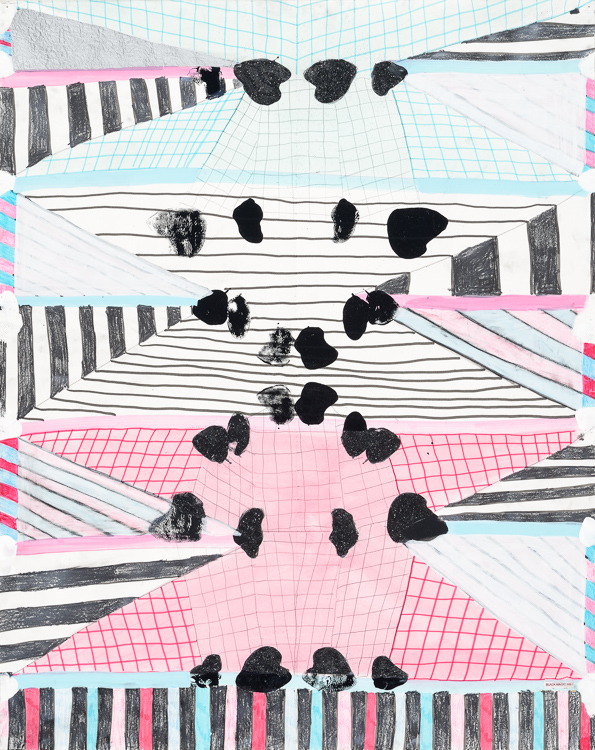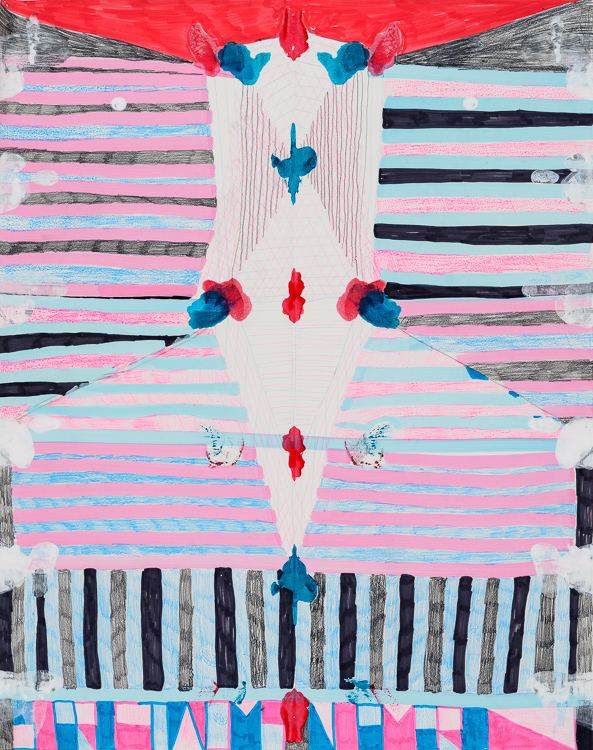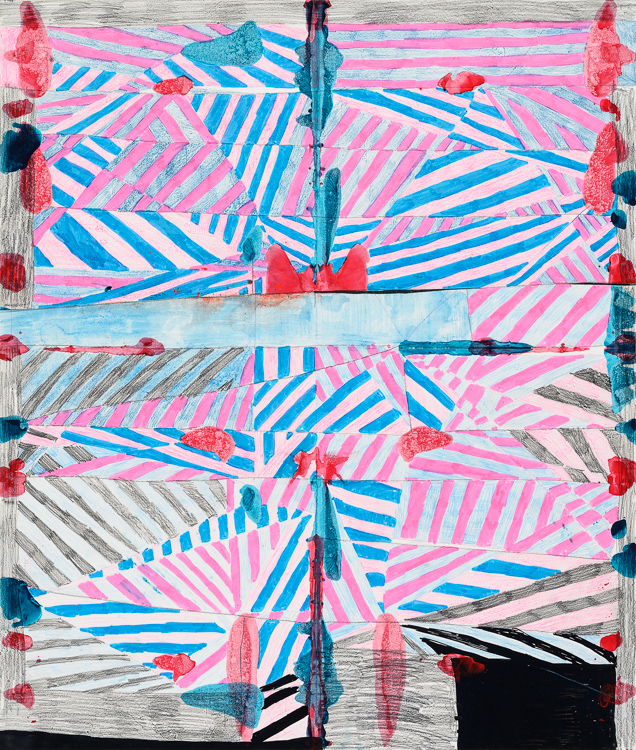The show currently on view at Brennan & Griffin Gallery, Coal For Wine includes five artists working with unconventional raw material elements in their practice—whether through painting, sculpture, collage, or bric-a-brac. Two paintings included in the show, by Brooklyn based artist Laurel Sparks, stand out in their relation to drawing, with their use of line as a primary language and structure.

Left: Laurel Sparks, Oneida, 2015. Acrylic, paper mâché, dirt, salt, selenite, pom poms, rocks, glitter, gold leaf, graphite, and watercolor pencil on canvas, 66 x 48 inches. Courtesy of Brennan & Griffin. Photo courtesy of Charles Benton. Right: Laurel Sparks, Rhinestone Voodoo, 2015. Acrylic, paper mâché, dirt, rocks, glitter, rhinestones, marker, gold leaf on canvas, 66 x 48 inches. Courtesy of Brennan & Griffin. Photo courtesy of Charles Benton.
Sparks’s paintings are heavily rooted in her drawing practice, as she works extensively on paper to develop the ideas and structure behind her larger works. These then develop to incorporate more physical materials and elements. Her paintings employ a varied use of mark making, and incorporate thin lines, bold geometric forms, and patterning. Unique textures slowly reveal their “ingredients” under intimate inspection to include everything from acrylic paint, graphite, pom-poms, glitter, rhinestones, salt, rocks, and dirt.

Laurel Sparks, Dazzle Drawing 4, 2013. Graphite, marker, colored pencil, ink, and glitter on paper, 28.5 x 23 inches. Courtesy of the artist.
The works occupy a unique space which treads the boundary between a formalist tradition of geometric abstraction and minimalist restraint, with equally present notions of impulsive excess and kitsch. A paired down use of line and structured form intermingles with intentionally unstable shapes and lines, which create an almost psychedelic distortion of space. Inspired by the mysticism of Paul Klee and Emma Kunz, and the dark theatrics of Kenneth Anger films and queer theater, her works carry a palpable tension, combining organic rawness with decadent artifice, composure with instability.
I had a chance to ask Laurel a few questions about the role of drawing in her work.
How would you describe your relationship to drawing in your practice, as a painter?
Drawing is essential to developing both the visual and conceptual structure of my paintings. Since the pressure on quality and financial investment is minimal, the process allows space for decisions to be impulsive and subconscious. The immediacy of drawing allows me to work out ideas in rough form and get lost in the rhythm of scribbling pigmented lines on a hard yet delicate surface. In comparison, my canvas work involves carefully studied pours and strategic placement of materials and brushwork. Drawings, whether quick sketches or developed images, supply the linear armatures for my paintings. The difference between the two is akin to weaving versus playing chess.

Laurel Sparks, Dazzle Drawing 3, 2013. Graphite, marker, colored pencil, ink, cutouts, collage, and glitter on paper, 28.5 x 23 inches. Courtesy of the artist.
As a young art student I did not set out to be a painter in a traditional sense. I used experimental materials and objects such as paper pulp, glass chunks and animal bones that could lend themselves to an installation practice. Tactility played a primary role towards activating synesthetic associations—touching, tasting, inhabiting, etc.

Laurel Sparks, Dazzle Drawing 2, 2013. Graphite, marker, colored pencil, and ink, on paper, 28.5 x 23 inches. Courtesy of the artist.
In some ways the paintings are formal in their considerations, and at the same time, there is a humor present where you resist too rigid of a structure. There is a playfulness both in your exploration of color, and your materials. Is this tension between a rigid or formal geometry and more playful exploration a driving force in your work?
Absolutely. Contradictions fascinate me, so formally, I attempt to set up interdependent relationships between binaries. The geometric systems in the painting give way to irregularities that recall the human body’s chronic (and involuntary) quest for equilibrium as it interacts with space and gravity. The unsteady lines offer a sense of shapeshifting and instability that considers the constant vibration of particles in all matter as much as the vicissitudes of the mind.

Laurel Sparks, Dazzle Drawing 1, 2013. Graphite, marker, colored pencil, and ink on paper, 27 x 23 inches. Courtesy of the artist.
Aspects of kitsch and irreverence co-mingle with devotional seriousness in the work. Pleasure and humor are powerful antidotes to social oppression and alienation. I look to Camp and radical queer performance as models for this contradictory aesthetic language, along with the broader history of the carnivalesque as it relates to outsider status.
Is there a distinction between drawing and painting for you?
Drawing seems more diplomatic than painting, since the practice traverses all media and genres. Its role is fundamental to most visual thinking and doesn’t carry the weight of its history the way paintings can.
Sparks’s paintings will be on view in the group exhibition, Coal For Wine, at Brennan & Griffin Gallery through July 26th. The show also features works by Peter Acheson, Cheryl Donegan, Geoffrey Farmer, and Vlad Smolkin, all of whom draw from disparate materials to create unique forms—refreshing in their raw physicality.
—Laina Terpstra, Visitor Services
